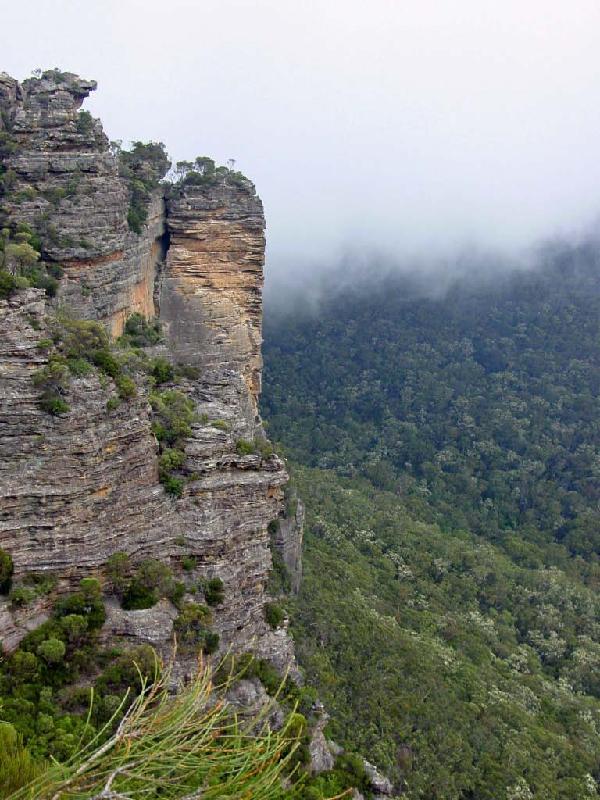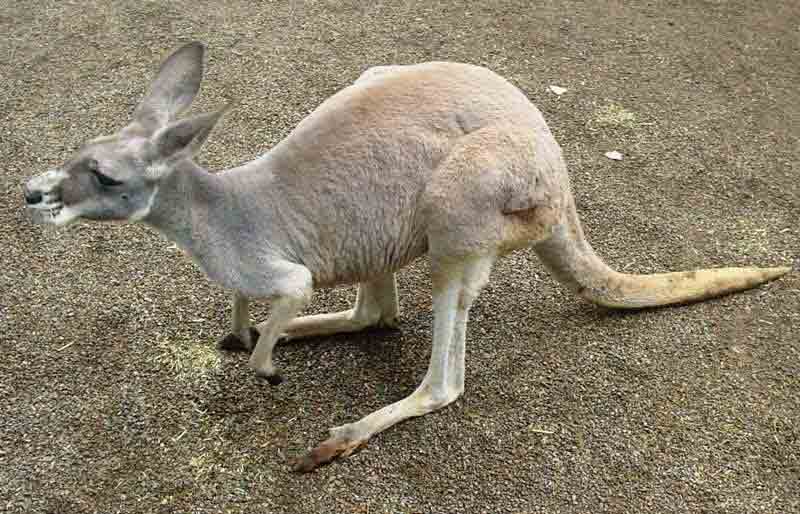|
|
AUSTRALIA'S UNUSUAL WILDLIFE
January 2006
Australia's animals are so unique they are almost close to alien as compared to animals living in other places on earth. This is because Australia has been isolated from other countries for at least 45 million years so the animals have taken their own special evolutionary journey. Just in case we didn't get an opportunity to see some of Australia's strangest creatures in the wild, we decided to visit one of the many wildlife parks.
We headed west out of Sydney in our little rental car bound for a day of adventure seeing the
Blue Mountains with a stop at Featherdale Wildlife Park. Patting koala bears is the primary attraction at the wildlife park which is home to hundreds of indigenous birds, reptiles and mammals native to Australia.
 Friendly Wallabies Friendly Wallabies
A large enclosure provided personal contact with the wallabies, with a shelter that the animals could go into if they tired of human company. But these little fellows seemed to really enjoy the visitors, especially is you had food for them. Most of the wallabies were Swamp Wallabies like the one we saw in the Hawkesbury Region but there are also Rock Wallabies, Wallaroos along with Red Kangaroos, Grey Kangaroos and even Albino Kangaroos. We all got a chance to pet the cute little marsupials and view them really close up,
even the rare Albino Kangaroo.
|
|
 Cuddly Koalas Cuddly Koalas
The Featherdale Wildlife Park is one of many Koala Bear Rescue Centres in Australia. There were an abundance of them sleepily hanging from gum trees. To our delight, a park guide removed a couple of bears from their perches and placed them where visitors could cuddle them and get pictures. The koala bears seemed totally oblivious to the activity but the guides were careful not to stress the animals too much and replaced them at intervals with other bears. |
|
 |
Koalas sleep 20 hours a day but didn't mind being disturbed for photos as long as there was eucalyptus leaves to chomp on. Then....back to sleep!
The koala's very low rate of metabolism is necessary to preserve energy required to digest the highly toxic eucalyptus leaves, which also have an effect like a drug to the
bears and keep them in a perpetual 'stoned' state. |
 |
Native Birds
The park was habitat to almost every kind of bird in Australia many of which we had been observing in our travels. Scores of the birds were not caged and chose to make the Park their permanent dwelling.
|
 |
Gord got friendly with a Cockatoo, the same birds that we had been listening to making such a racket every night while preparing to roost in their trees. This guy loved to have his head scratched. |
 |
Magpies are a common bird everywhere we've been. They have an ability to make the most unusual sounds and can become very bold where food is concerned. This one sits with a
Horned Owl. |
|
 |
 |
 |
 |
|
Emus are abundant in the Outback |
Common native Parrots flying free
|
Fairy Penguins in Sydney Harbour |
Kookaburro will eat from your hand |
|
AUSTRALIA'S UNUSUAL LANDSCAPE
 The Blue Mountains The Blue Mountains
The Blue Mountains get its name from the blue mist that rises from millions of eucalyptus trees and hangs in the mountain air, tinting both the sky and the range. The leaves of the eucalypt (gum) species have a heavy waxy coating to reduce water loss and they also have a fragrant oil to discourage herbivores. This oil is what gives the bush its blueish tinge.
The Blue Mountain area is surmounted by a plateau at an altitude of more than 1000 m where, over the years, rivers have carved ravines into the sandstone resulting in shear precipices and walled canyons.
On our drive we took detours to take in the scenic routes from
Penrith and Katoomba, the largest town in the Blue Mountains Park |
|
At Echo Point Lookout, the gnarly rocks of
the Three Sisters are spectacular 300 meter cliffs. We walked along some of the surrounding trails which always seemed to be uphill (both ways!) |
|
 |
 |
 |
 |
|
 |
Gord created a good likeness as he mimicked the face of the rock.
|
The viewpoint leads to an overlook of the
Giant Stairway, 1000 steep steps that wind their way downward, through the center of a rock pinnacle, and descend to the bottom of Jamison Valley.
We opted NOT to go down the stairs but took a drive to the Scenic World Complex to access the gorge instead. |
|
We arrived at the tourist heart
Scenic World Complex just as a very large group of Asian sightseers were unloaded off their bus. So we took the opportunity to wait for the crowd and the torrential rain to clear while having some lunch. |
|
Then we hopped on the
Scenic Railway, the world's steepest train that used to carry coal down a vertical inclinator into the valley floor. Not really a ride with the thrill of a roller coaster but gripping all the same. We exited the train onto an elevated boardwalk that led through the misty forest past the
old coal mine, where an audiovisual display told about the mine.
The
walkway continued through the gorge, protected from the rain by the
overhead canopy. |
 |
|
It looped through the rainforest and back to a platform where we boarded the
Skyway for our ride back up and out of the valley. |
 |
 |
 |
| Our journey continued and we stopped to hike to some waterfalls along the canyon including
Bridal Veil Falls, and Gordon Falls.
|
| Finally it was getting late so we just settled to enjoy the scenery on our drive back to Sydney via the
Bell's Line Road, which offered some nice views along the ridge road through
Wollemi National Park then on past the area's fruit and vegetable growing region. |
|
January 11,
2006
D-Day (Departure Day) had arrived for Chris. We drove to the airport and it was sad farewells as we watched him disappear through the gate. We hope his Australian experiences with us has enriched his life as much as his company has enhanced and lifted our spirits. We will miss him and will look forward to the next opportunity to be together again in another foreign country. |
|

 Friendly Wallabies
Friendly Wallabies







 Cuddly Koalas
Cuddly Koalas 





















